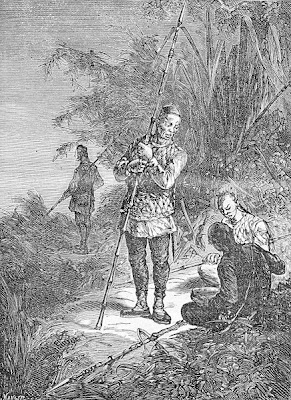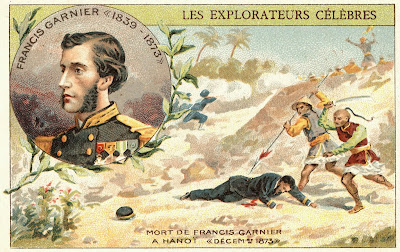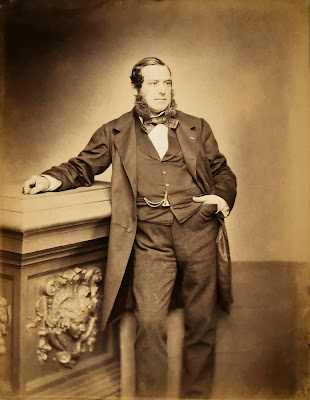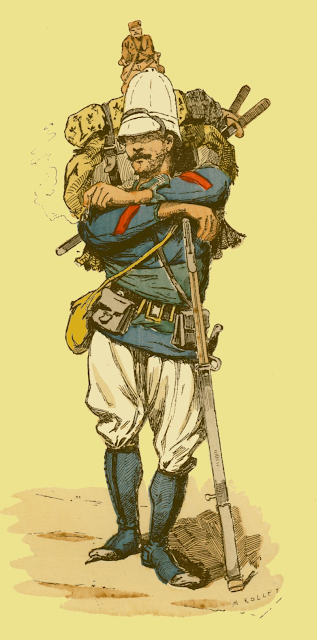Background
France’s early campaigns fought in Northern Vietnam from 1881-1889 form just the tail-end of a greater narrative of Franco-Vietnamese and Franco-Sino (Chinese) conflict for control over the Tonkin (Tonquin or Tongkin) province of North Vietnam. The Battle of the Paper Bridge (Cầu Giấy) in 1883 was arguably the first major conflict in France’s commitment to conquer and pacify what became Vietnam and French Indochina (1896-1954).
The Tonkin Expeditionary Corps takes Bac Ninh in 1884
The first major Franco-Vietnamese clash came with the Bombardment of Da Nang in Southern Vietnam (Cochinchina) in 1847 by two French ships commanded by Admiral Jean-Baptiste Cécille. He destroyed numerous Vietnamese ships or junks and reportedly killed over 1,000 in his shelling off what the French called Touranne. A punitive French campaign in southern Vietnam began in 1858-1862.
Using both Gunboat Diplomacy and interventionist forces on the ground the French and their Spanish allies were led by Admiral Charles Rigault de Genouilly who led the bloody siege and capture of Saigon in February 1859, the French ultimately succeeded in defeating the Vietnamese empire for control of Cochinchina (southern Vietnam) after a series of campaigns and battles following the Capture of Vinh Long in the year 1862.
Using both Gunboat Diplomacy and interventionist forces on the ground the French and their Spanish allies were led by Admiral Charles Rigault de Genouilly who led the bloody siege and capture of Saigon in February 1859, the French ultimately succeeded in defeating the Vietnamese empire for control of Cochinchina (southern Vietnam) after a series of campaigns and battles following the Capture of Vinh Long in the year 1862.
French ships bombarding Touranne, what is today Đà Nẵng, Republic of Vietnam
Two years later Cochinchina became a French territory and protectorate. Thus a larger military presence followed through the stationing of naval vessels in the Vietnamese/China seas and through stationing garrison duty French Foreign Legionnaires throughout strategic outposts in south-central Vietnam. Colonization began though civilization projects, Catholic missionary outreach, and commerce once the fertile Cochinchina territory had been secured for European (French) influence beginning in the mid to late 1860’s.
The Black Flag Army, 1853-1883
Liu Yongfu or Liu Yung-fu (Lưu Vĩnh Phúc) and his Black Flag Army can trace its roots back to its commander-in-chief’s and founders origins as a bandit/mercenary soldier fighting in the Taiping Rebellion of 1850-1864. In southern China Yongfu joined other Taiping princes and rebel leaders in attempting to free China from Qing domination under the proto-Christian revivalist and anti-Western leader of the rebellion Hong Xiuquan (b.1814-1864).
General Liu Yongfu in his most well known portrait taken later in life
“General” Yongfu fought in numerous actions and skirmishes with his small band of outlaws and raiders under his personal standard, a simple black flag, during the bloody attrition civil war. It was this flag which was first carried in the great Taiping conflict that became the symbol and battle flag of Yongfu’s mercenary army. Following the crushing of the Taiping Rebellion in 1864 and the capture of Nanking, Yongfu fled into Northern Vietnam after an invitation from Emperor Tự Đức (b.1829-1883).Yongfu’s Black Flag Army proved themselves more than useful hunting down and pacifying the rebellious and unruly northern mountain clans for the Vietnamese Emperor throughout the 1860’s and early 1870’s.
Later in 1884 and 1885 the Black Flags would fight as allies of Qing China and the Kingdom of Vietnam against the Tonkin Expeditionary Corps and the invading French army and navy. Armed by China, in the 1880's, Yongfu and his Black Flag army resided at their base of operations at Son Tay on the Red River north of Hanoi.
Black Flag soldiers c.1873
Believing he could conquer all of northern Vietnam he took Hanoi by force and attempted to increase French influence in the area by the sword. Despite the protection of his own warship and a handful of French marines a large Black Flag contingent eventually attacked Hanoi and Garnier was killed outside the city gate cut off from his marine bodyguards. His head was severed and taken as a grisly trophy of victory by the Black Flag Army. What amounted in French eyes to cold blooded murder would not go unanswered however.
Garnier was disavowed by the French cabinet and military officials who quickly sought to distance themselves from his actions. Newspapers in Paris denounced him as a foolhardy adventurer and pseudo filibuster who nevertheless died heroically fighting against the treacherous and unpredictable “yellow” peoples of the Tonking. Sino-French or any larger Franco-Vietnamese conflict was avoided following the death of Commandant Garnier with a Sino-French treaty in 1874 which opened more of Northern Vietnam and the Red River Delta to French traders and French interests, in theory. In the early 1870’s-1880’s shipping and commerce were affected however by open hostilities between the Vietnamese-Black Flag Army and Franco-European traders operating in the northern regions.
Garnier's infamous end from a 20th century artists' depiction
Riviere’s Expedition 1881-1883
A second French expedition to Tonkin and Northern Vietnam was launched beginning in late 1881 and led by Commandant Henri Rivière. A career officer who was known to be a cultured and well read man of letters, Rivière served in the French naval service on a number of vessels from the Crimean conflict in 1854-1856, to the Mexican Intervention of the 1860’s, as well as in the Franco-Prussian War of 1870-1871. In the year 1876 he was assigned to the frigate La Vire and stationed in the southwestern Pacific Ocean in the French colony of New Caledonia. There from 1878-1879, Commandant Rivière fought and eventually defeated an uprising of the native Kanak people led by their chief Atai who was eventually killed in 1878.
Henri Rivière in civilian life circa 1859
Rivière continued to wage an anti-insurrection campaign in New Caledonia until granting a general amnesty to all surrendering Kanak rebels. For his service he was awarded with captainship over his own vessel and was later stationed in a flotilla near Saigon in the French colony of Vietnam (Cocinchina) from 1880-1881. Rivière served in the Division Navale de Cochinchine or the Cochinchina Naval Division, and was responsible for patrolling the Vietnamese and Cambodian coasts with the Tonkin Flotilla.
Rivière as an officer in the mid to late 1870's
With 700 Marines and three gunboats he took the citadel at Hanoi in April of 1882, the same location that Commandant Francis Garnier had died trying to defend in December of 1873. This was a bold action and was not sanctioned by the government of Prime Minister Jules Ferry in Paris, though it was generally hailed as a great success by the military men stationed in country at the time. Hanoi was indefensible and though it was mostly a symbolic victory it was still an entirely foolhardy endeavor destined to bring greater conflict. Eventually Rivière shrewdly began to negotiate with Qing diplomats as to how best to divide Tonkin and Northern Vietnam into Sino/French spheres of influence. It would all be for naught.
French Marine dressed for service in Tonkin c.1883
Rivière gained great renown in March of 1883 when he captured one of the largest and most important cities in the Red River Delta, Nam Định, southeast of Hanoi. Though his initiative was questioned again the capture of Nam Định was a great victory however the fruits of that victory would die on the vine. By now the Black Flag Army and the Qing were openly supporting the Kingdom of Vietnam, the former with battle hardened soldiers under the command of the able general and warlord Liu Yongfu. Chinese soldiers had or would soon occupy great portions of Northern Vietnam in the first moves in the expansive Sino-French War (1883-1885).
Rivière, left, in battle with his French marines against the Vietnamese at Nam Dinh
Battle of the Paper Bridge, 19 May 1883
In April and into mid-May 1883 French occupied Hanoi had been nearly encircled by a combined Black Flag and Vietnamese army. Yongfu’s Black Flag army were most likely in their natural element, preparing ambushes and raiding parties for the inevitable clash with the French that was to come. The Rivière column marched from Hanoi in early morning hours of 19 May in an effort to meet the Black Flag army in the field and destroy them. Black Flag spys reported the French columns movements as they left Hanoi and marched towards the villages near Cầu Giấy across the Paper Bridge.
This French column was at a strength of around 550 men though the active strength was much lower in reality. These soldiers were marines, sailors and the landing companies from Rivière's gunboats, though perhaps dozens upon dozens were feeling unwell or sick, Commander Rivière amongst them. Because of this command of the column went to the chef de bataillon, Berthe de Villers (b.1844-1883), a career soldier and officer of the line with experience in several notable campaigns and battles before his service in Tonkin.
Officer Berthe de Villers, victor at the Battle of Gia Cuc in March of 1883, mortally wounded in relief command of a French column at the Battle of the Paper Bridge, May 19th 1883
Battle for the Bridge
The battle began as an ambush and minor skirmish whilst the column under the commander of chef de bataillon de Villers marched across the Paper Bridge toward the village of Cot (Ha Yen Khe). This region and the surrounding villages of Cau Giay outside of Hanoi were known for their manufacturing of paper during these days and hence the name of the area's most well known and used bridge.
During the early portion of the engagement a frantic skirmish appeared as rifle fire was exchanged by both sides. Black Flag skirmishers devastated the French line who were most likely unable to see their enemies line of fire. As the situation developed the French line deployed and held fast for the oncoming attack. Their officers were unaware that Yongfu held a thousand or more men in reserve awaiting the signal to attack the French positions once they had fully committed to marching towards the village of Cot. The French line would stand for less than half an hour before it soon wavered under an intense charge and volley attack by the Black Flags.
Volley fire as well as sporadic (sniping) rifle-fire were costly to both sides and at such close range it was actually the synchronized volleys which were perhaps the most deadly in the thick of the battle. De Villers was mortally wounded in such a volley by a cadre of advancing Black Flags. An organized fighting retreat was ordered by Rivière when he full grasped the situation. He sprang into action following the grievous wound to de Villers and was in the heat of the battle. The French marines and sailors used their 11mm Fusil Gras mle 1874 rifles and sword bayonets to little effect it seemed. Soon Rivière and his column retreated across the bridge in haste; dozens killed or wounded already by the surprise Black Flag ambuscade.
The French must have been shocked when their officers and enlisted men alike fell one after the other to accurate and concentrated rifle fire delivered by the nevertheless well drilled, trained, and battle hardened Black Flags. A retreat was made in good order as the column received covering fire from the three cannons which may have been more effective had not many of the artillerymen been sick. Disaster struck soon after however when one of the 65mm cannons fell over due to recoil and became stuck in the mud.
Rivière attempts to free his gun at the Paper Bridge in a 20th century depiction
Many more fell until the retreat had been completed and the surviving French marines, sailors, and soldiers retreated across the Paper Bridge. The actions of a naval lieutenant named Pissère were held in high regard because it was he who organized the end of the retreat, the defense of French positions following their defeat. and the march back to Hanoi. Behind natural earthen breastworks they defeated Black Flag attempts to breach their retreat lines and eventually double marches back Hanoi later that same day. In the confusion Commander Rivière's body was left on the field of battle. French losses in this battle totaled 35 men killed and at least 50 wounded if not more. The Black Flag army suffered at least 50 men killed and perhaps double that number wounded including two officers slain.
Related Posts
Taiping Rebellion 1850-1864: Opium Conflicts & Early Western Intervention in China
Suggested Further Reading
Suggested Further Reading
French Foreign Legion 1872-1914, M.Windrow & M. Chappell (Osprey Publishing)












Very nice article.
ReplyDeleteIf you want your ex-girlfriend or ex-boyfriend to come crawling back to you on their knees (no matter why you broke up) you have to watch this video
ReplyDeleteright away...
(VIDEO) Text Your Ex Back?
ReplyDeletemerci pour votre post.it informatif utile pour comprendre it.keep blogging
expédition chine